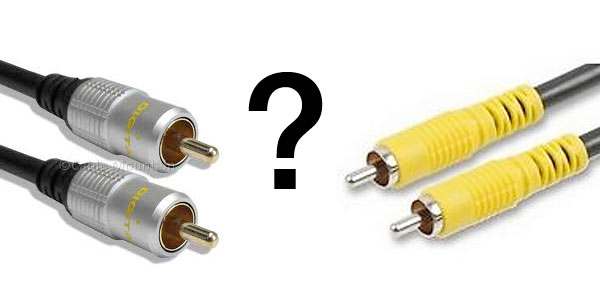A Simple 75 Ohm Video Cable
I think his name was Don. He was one of the attendees at the recent CES show that insisted that I could improve the sound of my demonstration Blu-ray disc by swapping the inexpensive video cable that I was using for an expensive alternative. I flat out told him that it wouldn’t make any difference at all…that getting the data stream from the Kanex Pro box to my Benchmark DAC2 was a fairly simply thing to do and that my $.50 cable was doing it just fine.
Remember we’re talking about digital connections. I’ll talk soon about the merits of quality cables (notice I didn’t say expensive!) but in the present case all the cable needs to do is pass a 96 kHz/24-bit bitstream about 3 feet. Success means that there aren’t excessive data errors between the source and the destination. These are known as dropouts and if there are an excessive number of them, it can cause a digital “snat” or momentary silence. But there are very sophisticated error detection and error correction data handling routines (Reed Solomon) built into the standards that virtually eliminates dropouts…especially at very short distances. The chances that my inexpensive cable would fail to deliver the electrical impulses that are ultimately decoded as digital ones and zeros at the new DAC are very small.
So while it is possible for a more expensive cable to have better specs and fewer dropouts, if my yellow ended RCA video cable gets the same digital information to the Benchmark, it’s game over. The output of the DAC2 will be identical in each case.
Don’s retort was that he knows a bunch of really smart people that insist that a better quality cable would dramatically improve the fidelity of my sampler. He first brought up the possibility for temporal skewing or jitter that would be much higher in a cheap cable. It’s true that jitter can degrade the audible quality of a digital transmission. But any competent electrical engineer charged with building a high-end DAC would provide a completely new and independent clock in their device. They would reject the clock coming down the line with the data stream. So an argument based on timing errors fails.
Then Don asked me if I had ever heard of the $2000 per copy glass compact discs that someone in Japan has been issuing (I had heard that they were only $1000 per copy…but even at 50% off, they are complete snake oil deserving of a “Tweakie” Award). Don insisted that the pit geometry of glass discs provides a “better” data stream than regular stamped CDs made of polycarbonate. Nonsense.
I asked if he knew how optical discs function. I explained that the fundamental concept present when any optical disc is read requires the pickup to determine the difference between only two states. If the laser is reflected back, you get one state…it not the other. As far as I know, a mirrored piece of glass is no more capable of doing this successfully than an aluminum sputtered polycarbonate disc (assuming the discs are properly replicated). We only need to ensure that the pickup can tell whether the lights are on or off…two states. With the data stream coming in and a new clock applied, there can be no difference between the cheap cable and the expensive cable.
Some of the comments on yesterday’s post correctly stated reasonable quality cables are perfectly able to accurately transmit digital information at short distances just as well as an expensive one. They’re right…save your money.
By this time, the discussion at the booth was past the point of no return and others gathered basically asked Don to move on. We shook hands and he departed.
I’m considering capturing the output of my cheap cable and then the output of an expensive cable and doing a bit by bit comparison. If, as I expect, the data streams are identical, then the output of the DAC2 will be the same from either one.
We’re talking about digital cables. This includes HDMI, coaxial, USB and CAT-5 cables…that are properly manufactured and meet the format specifications. We shouldn’t be spending outrageous sums of money on getting our digital bits from one place to another.


“We shook hands and he departed.”
Didn’t you consider the risk of rabies? 😉